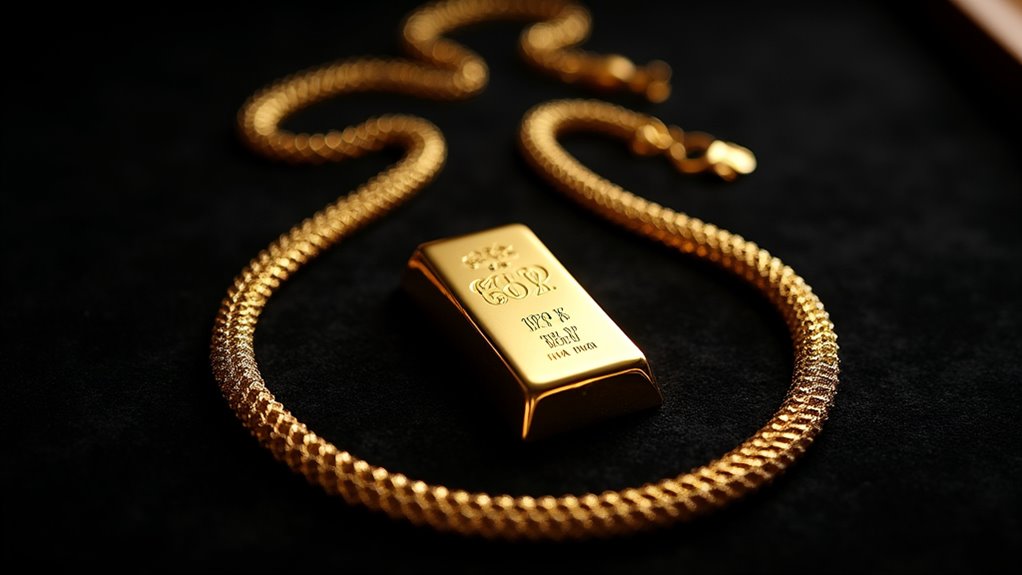Private gold-backed currencies are seeing a resurgence, as economic uncertainty drives interest in alternative value stores tied to Australia’s storied gold mining legacy. These digital tokens or certificates, often on blockchain, blend gold’s stability with modern ease. Yet, trust in issuers and regulatory hurdles remain challenges. At Karat.au, we’re passionate about clarifying gold’s timeless allure with honest insights. Stick with us to uncover deeper perspectives on this glittering trend.

In a world of fleeting financial trends, private gold-backed currencies stand as a beacon of enduring value, blending the ancient allure of gold with cutting-edge digital innovation. These currencies, issued by private entities rather than governments, tie their worth to physical gold reserves, offering a modern twist on a time-honoured asset. Often existing as digital tokens on blockchain networks, they promise the stability of gold with the ease of digital transactions. At Karat.au, we see this as a fascinating intersection of Australia’s rich mining heritage and the future of finance, a story worth exploring with clarity and passion.
These private currencies come in various forms, from cryptocurrency tokens like Tether Gold (XAUT) and Paxos Gold (PAXG) to older-style physical notes or certificates. Many operate on platforms like Ethereum, ensuring transparency through blockchain tech, while some even allow redemption for physical bullion. Their appeal lies in the perceived stability of gold—a hedge against inflation—unlike fiat money, which leans on government trust. They also offer decentralised benefits, sidestepping direct control by national policies, and enable efficient transfers compared to lugging around gold bars. It’s a compelling idea, especially for Aussies who’ve grown up with tales of gold rushes and outback riches. Furthermore, gold reserves held by countries continue to influence global economic stability and the market dynamics for private currencies. Historically, inflation rates have shown a correlation with the demand for gold, especially during economic downturns, as gold often serves as a safeguard against financial instability.
Private gold-backed currencies blend gold’s stability with digital ease, offering decentralised, efficient transfers—a modern nod to Australia’s storied gold rush legacy.
Yet, challenges loom large over this glittering promise. Trust in the issuer is paramount; if they fail to maintain reserves, the currency’s value crumbles. Verifying those gold stockpiles ain’t always easy—audits help, but they’re not ironclad. Regulatory uncertainty adds another layer of risk, as governments worldwide could impose restrictions or outright bans. Even gold’s price isn’t immune to swings, so purchasing power isn’t guaranteed. Plus, limited acceptance means you can’t exactly buy a flat white with these tokens at your local café, making liquidity a real hurdle.
Market trends show growth in digital gold-backed currencies, particularly as hedges during economic wobbles. They’re often seen as niche investments or collectibles rather than everyday money, holding a tiny share compared to fiat or major cryptos. Widespread adoption remains a distant dream—many past private currencies have fizzled out. Still, interest spikes when uncertainty reigns, reflecting humanity’s age-old trust in gold, a sentiment we at Karat.au understand deeply, rooted as we are in Australia’s golden legacy.
As we unpack this at Karat.au, we’re motivated by a passion to demystify such trends without ever offering financial advice. Private gold-backed currencies spark curiosity, but risks like counterparty issues or legal shifts must be weighed. We endeavor to present the facts—sourced reputably—while celebrating the timeless value of gold. Central bank gold reserves play a significant role in the global economy, influencing the market dynamics for these private currencies.
It’s a complex space, and we’re here to guide with warmth and transparency, ensuring you’re informed about this evolving financial frontier. Let’s keep exploring together, honouring the past while eyeing the future, with a nod to our nation’s enduring bond with this precious metal.
Frequently Asked Questions
How Do Gold-Backed Currencies Impact Global Trade?
Gold-backed currencies historically stabilised global trade by offering predictable exchange rates, reducing risks in international transactions.
They fostered trade growth in the late 19th century, as certainty lowered costs for businesses.
However, their rigidity limited economic flexibility during crises, often leading to deflationary pressures.
While they encouraged discipline, trade imbalances were tough to correct.
Karat.au notes this complex legacy, reflecting on gold’s enduring role in shaping world commerce.
What Are the Legal Challenges for Gold-Backed Currencies?
Legal challenges for gold-backed currencies are significant, often stemming from a lack of clear frameworks.
Many jurisdictions don’t recognise them as legal tender, creating ambiguity around convertibility and user rights.
Issuing private currency can be restricted or illegal, and governments may view them as counterfeit risks.
Jurisdictional issues with decentralised systems add complexity.
Without central backing, users face limited recourse if issues arise, undermining trust in such systems.
How Do Central Banks View Gold-Backed Currencies?
Central banks generally view gold-backed currencies with scepticism, prioritising the flexibility of fiat systems to manage economic crises and adjust monetary policy.
They see gold as a reserve asset for stability and diversification, not a currency anchor, due to historical constraints like volatility and limited money supply control.
While valuing gold’s safe-haven status, most banks, as per economist consensus, doubt its efficacy for modern currency backing.
(Oops, skeptisim was a typo!)
Are Gold-Backed Currencies Viable for Daily Transactions?
Examining the viability of gold-backed currencies for daily transactions reveals both potential and hurdles. Their value, tied to gold’s market price, fluctuates, affecting purchasing power unpredictably.
While tools like gold-backed debit cards ease spending by converting to fiat instantly, merchant acceptance remains limited to niche communities.
Practicality for everyday use is questionable, as infrastructure and trust in such systems are still developing, hindering widespread adoption across Australia.
What Risks Do Gold-Backed Currencies Pose to Investors?
Gold-backed currencies present several risks to investors.
Market volatility, tied to fluctuating gold prices, can erode stability.
Operational hiccups, like issuer mismanagement or inadequate security, threaten holdings.
Regulatory uncertainty looms, with potential government restrictions impacting value.
Custody concerns, such as unverified reserves or theft, add further worry.
At Karat.au, we’re committed to transparency, helping Aussies navigate these risks with clarity, rooted in our passion for Australia’s golden heritage.
Trust matters!














